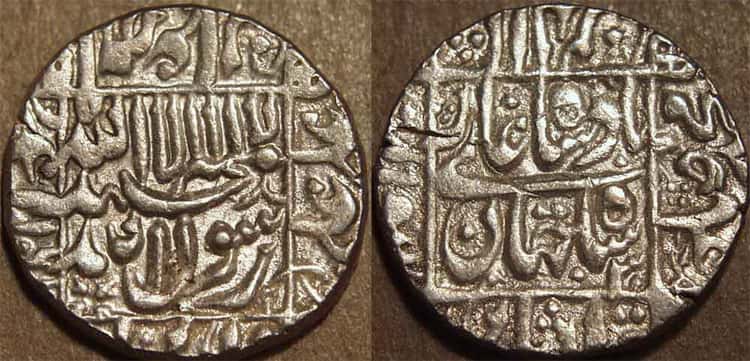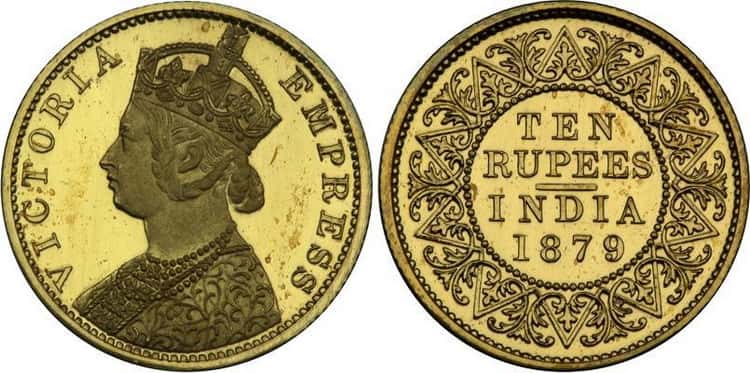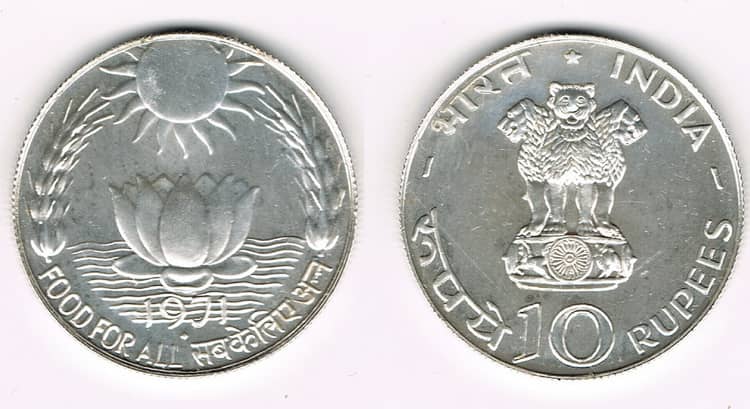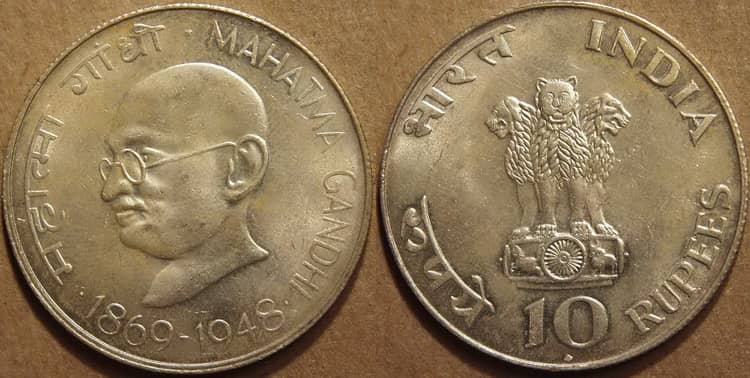
10 Indian rupees (Mohur) is a monetary unit that plays a leading role in the financial circulation of the country and abroad. Some states in South Asia (Pakistan, Nepal, Seychelles, Indonesia, Sri Lanka, Mauritius) also have been using this coin as a means of payment since ancient times. The history of the old samples covers almost five centuries, so it has lots of interesting facts.
History
For a long time, India was a multitude of small Mahajanapadas – an independent principalities and republics. Trade was actively pursued between them. The bars as well as gold and silver coins were used as a currency. In different territories there was its own version of the monetary unit, but after the Islamic invasion, the situation has changed.
Most of the territory of the future India became a part of the Mughal Empire. With the beginning of Muslim rule, a single monetary system emerged in the country. The decisive moment for the coin came after the conquest of Humayun Sher Shah Suri. The new ruler created a civil and military administration, issued a new coin in silver, corresponding to 176 troy facets (translated from Hindi rupee − “silver coin”).

The first coins of 10 Indian rupees appeared in India under the ruler of Sher Shah (1539–1545), and became widespread under Akbar the Great (1556–1605). The new monetary unit came into use in the South of the country (along with 1 Indian pagoda), later in the central and northern regions. For its production used high-quality silver 970 samples (the weight of the coin was 11,534 grams). The regular coinage was made round in shape, but there were gift copies − rectangular coins with memorable inscriptions and blessings.
Did you know? The last rupee of the Mughal times is the coin of Muhammad Shah minted between 1744 and 1748 in the city of Benares (modern Varanasi). The ruler was elevated to the throne by two brothers, Sayid, whom he soon ordered to kill. He seized India, but the prospect of governing the country attracted him little. The emperor was more interested in culture and art than in the fate of the state. The decline of the once mighty empire opened the way to the British, who eventually took control of most of the country.
By the time most of India was colonized (1677, during the time of the East India Company), silver 10 rupees of Sher Shah became a popular standard in the state. Despite many attempts by the British to introduce the British pound as the main currency of the country, the coin could not be ousted. Its popularity only grew, so silver rupees began to be exported to other colonies belonging to Great Britain.
Did you know? A rare sample is stored in the Victoria and Albert Museum (UK) − a gold coin of 10 rupees of 1870 with a portrait of Queen Victoria. The quality of the copy is Proof, which is quite unique for this period. A precious sample was minted in India at the Calcutta Mint. The author of the portrait was the British engraver Leonard Charles Vaughn. The diameter of the coin is 26 mm, weight − 7.794 grams.
During the period of the East India Company, several types of rupees circulated:
- Bombay “Sirat”
- Madrassian Arcot
- Bengali Sikka.
Until 1893, a silver standard operated in India (the course was determined based on the price of the precious metal in the world). Any resident of the country could transfer the silver to the Mint and get the appropriate amount of coins or banknotes. In the same period, copies of gold were produced − 1 Indian mohur, which corresponded to 15 rupees, and after the abolition of the silver standard − 10 rupees.

In 1947, India became an independent country. From this point on, coins of 10 rupees were replaced with paper banknotes. The reason for such drastic changes was that Indian precious metal samples were tied to the silver standard, so their value varied depending on the value of silver on the stock exchanges. In addition, there was no benefit when trading with countries that adhere to the gold standard. It was much more profitable to issue paper currency.
Did you know? Since 2005, coins of 10 rupees have been minted in India only for special events of bimetal or silver. Anniversary samples come out in limited editions. The design is diverse − memorable specimens are dedicated to great people and important periods in the history of the country.
Famous series of coins of 10 rupees from bimetal (copper / nickel, aluminum / bronze):
- 2005–2007 − Unity in diversity
- 2008 − Communication and technology
- 2009 − 100 years since the birth of Homi Jehangir Bab
- 2010 − 100 years of the Reserve Bank of India
- 2012 − 60 years to the Parliament of India
- 2012 − Silver Jubilee of the Council of the Temple of Sri Mata
- 2015 − 100 years of the return of Mahatma Gandhi from South Africa
- 2015 − 100 years since the birth of Shinmayanandas Saraswati
- 2015 − International Day of Yoga
- 2016 − 125 years of the National Archives of India.

Silver 10 rupees were minted in limited edition. The most recognizable series of 1969 is dedicated to the 100th anniversary of the birth of Mahatma Gandhi (1869-1948), and the coins of 1970-1973 are called “Food for all”.

Design
10 rupees of the Mughal rule were covered with classical Arabic script. The denomination on the coins of that time, as a rule, was absent. Masters in different cities and industries minted numerous options, not limited to the same drawings. The first rupees of the East India Company, produced in 1671, did not differ in design from the coins of the Mogul Empire. The British basically tried to imitate copies of past rulers. Only the quality varied depending on the region (Madras, Bengal and Bombay). In 1835, the design was unified − portraits of kings of Great Britain began to be depicted on the surface of the coin.

Modern bimetal commemorative coins have a common standard pattern on the obverse. On the surface of 10 rupees in the center is the emblem of India − “the lion capital”, crowning the column of the Emperor Ashoka. The image of this sculpture has been declared a national symbol of the state since January 26, 1950, right after it acquired the status of a republic. Below is the inscription in Hindi in the translation “ONLY TRUE WON”. On the outer ring on the left is the name of the country in Hindi, on the right – INDIA, at the bottom of the year of minting.
Did you know? The Ashoka Column, adorning 10 rupees, is the national symbol of India. For the first time, pillars with a height of 12–15 meters with Indian writing and animal drawings appeared during the reign of Mauryev. Facilities were installed where it was crowded. Nearby was a minister who explained to the illiterate population the essence of the inscriptions. The purpose of the building is effective state propaganda. Later, the Muslim government destroyed the sculptures with images of living beings. In 1851, archaeologists found a capital with lions, and it was she who in 1950 became the emblem of India.
Since 2010, a national currency symbol has appeared on the rupee. The emblem was chosen from thousands of options sent from all over India. It is a grapheme of the Indian alphabet, which is close in writing to the Latin letter R. The sign has no vertical line, its upper part is crossed out with two lines. The idea belongs to Uda Kumar – a student at the Indian Polytechnic University (Mumbai). The author received 5,500 dollars for it.
Circulation
The exact amount of silver 10 rupees of the Mogul domination and times of the East India Company is not known. The country had a lot of precious metal reserves. It is known that in the period from 1835 to 1893 silver coins worth more than 3 billion 300 million rupees were minted. Since 2005, all modern commemorative copies of bimetal have been minted in print runs of 2,000,000 samples, of silver – no more than 26,000 samples.
Cost of coins
The price of 10 rupees depends on the year of minting, metal and safety:
- modern bimetal samples − 1-3 $ USD
- modern silver samples − 29-35 $ USD
- samples of the times of the Great Mogul − from 1,000 $ USD
- samples of the East India Company − from 500 $ USD
Of particular value is the 1975 model of the FAO theme from copper and nickel. The cost of this instance at auction reaches 35-40 $ USD.
Comments
No commens yet.